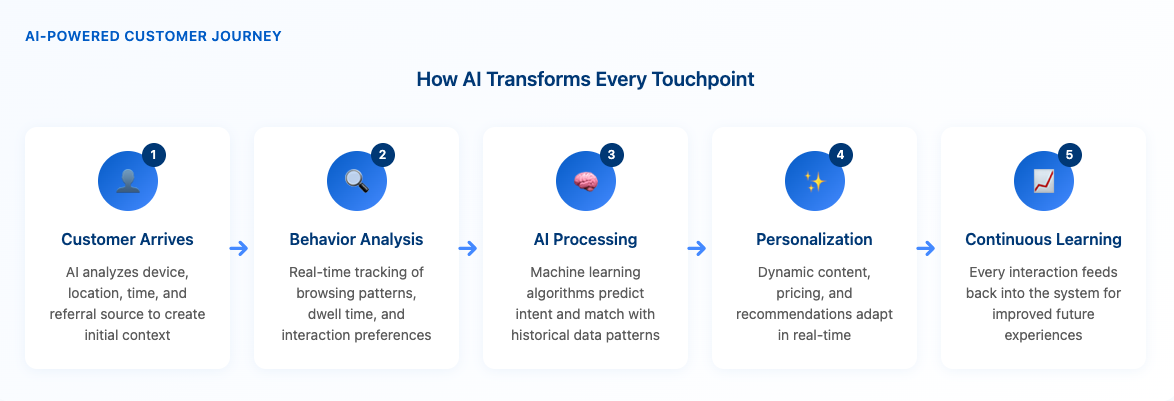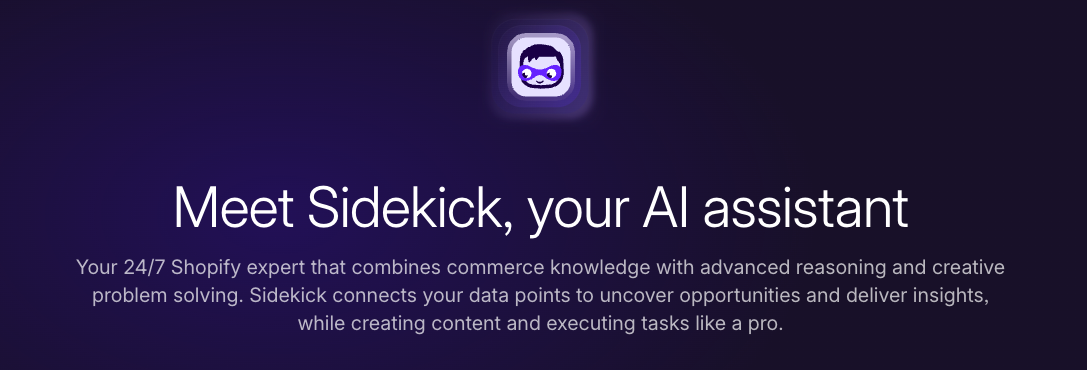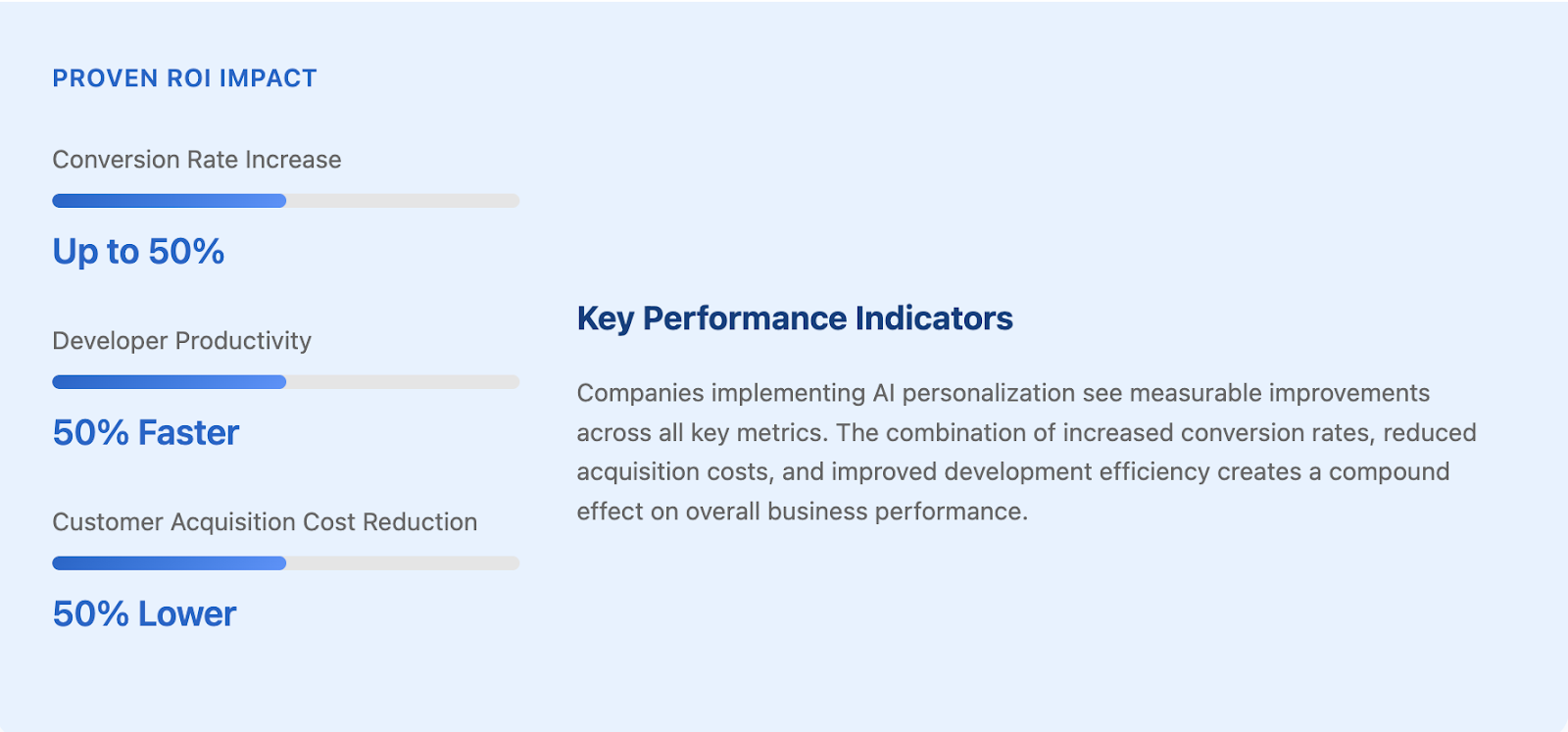Here’s what’s happening in eCommerce right now: customer expectations have fundamentally shifted, and your competition is adapting faster than you might think.
Today’s shoppers arrive at your website already knowing what personalized experiences look like. They’ve been trained by Amazon’s uncannily accurate recommendations, Netflix’s spot-on content suggestions, and Spotify’s perfectly curated playlists. They don’t just want personalization—they expect it as the baseline.
Meanwhile, your competitors aren’t just collecting customer data; they’re using AI to predict behavior, customize pricing in real-time, and create individualized shopping experiences that feel almost telepathic. While you’re still sending the same email to your entire database, they’re crafting messages that reference specific browsing behavior, abandoned cart items, and purchase timing patterns.
The gap between businesses using basic personalization tools and those implementing AI-driven strategies is widening rapidly. The companies embracing these technologies aren’t just seeing incremental improvements – they’re completely redefining what their customers expect from online shopping.
- The Business Case for AI-Driven Personalization
- How We Got From "People Also Bought" to Mind-Reading AI
- The Platform Wars: How the Big Players Are Actually Doing This
- The Technology Behind the Magic
- What This Actually Looks Like When You're Shopping
- The Customer Segmentation Revolution That's Actually Happening
- Dynamic Pricing: Controversial but Incredibly Powerful
- The Privacy Challenge We Can't Ignore
- The Numbers Don't Lie: Real-World Impact
- Voice Commerce: The Next Big Thing
- Platform Integration and the Future
- The Human Element in an AI World
- The Platform Selection Decision
- The Bottom Line
The Business Case for AI-Driven Personalization
The market opportunity is substantial and growing rapidly. The e-commerce market’s use of AI jumped from $7.25 billion in 2024 to $9.01 billion in 2025, and is projected to reach $64.03 billion by 2034.

This represents a compound annual growth rate of 24.34%, indicating strong enterprise adoption across industries.

The performance metrics speak for themselves: Companies that prioritize personalization in their marketing strategies achieve revenue growth of 6-10%. More specifically, personalization strategies can drive a 20% increase in sales.
What makes these results particularly significant is the shift from reactive to predictive customer engagement. Modern AI doesn’t simply respond to past behavior—it anticipates future needs and preferences, enabling businesses to deliver relevant experiences before customers even realize what they’re looking for.
This represents a fundamental evolution from the basic recommendation engines that dominated early eCommerce to sophisticated systems that understand context, intent, and individual customer dynamics.
How We Got From “People Also Bought” to Mind-Reading AI
Traditional personalization was pretty crude, if I’m being honest. It relied on simple rules: “If they bought X, show them Y.” Or collaborative filtering: “People like you also liked Z.” These approaches worked when our expectations were basically nonexistent, but they feel embarrassingly clunky now.
Modern AI personalization operates on a completely different planet. It combines machine learning algorithms and natural language processing to analyze data from websites, apps, and social media. We’re talking about technology that actually understands context.

Instead of just tracking what you purchased last month, today’s AI analyzes:
- Your browsing patterns and how long you linger on specific categories
- Social media interactions and the sentiment behind them
- How your shopping behavior changes with the seasons
- Whether you’re a morning browser or midnight impulse buyer
- Which device you prefer for research versus actual purchases
- How weather and location influence your buying decisions
The AI adapts dynamically to external factors too—time of day, seasonal trends, even what device you’re using. It’s contextual intelligence that actually makes sense.
The Platform Wars: How the Big Players Are Actually Doing This
Here’s where it gets really interesting. The major eCommerce platforms aren’t just talking about AI—they’re building it into everything. Each platform has taken a slightly different approach, but they’re all racing toward the same goal: making personalization accessible to businesses of every size.
Adobe Commerce (Magento): The Enterprise Heavyweight
Adobe Commerce has probably gone the furthest in actually integrating AI into the core platform experience. They offer AI search tools, personalized promotions, and real-time data sharing. The platform provides 13 AI-powered recommendation options across your site.
What genuinely impresses me about Adobe’s approach? They’ve made Adobe Sensei—their AI engine—feel like a natural part of the platform instead of some awkward bolt-on feature. Product Recommendations powered by Adobe Sensei is now available to Magento Commerce merchants globally. Adobe Sensei automatically analyzes shopper behavior through multiple machine learning algorithms, eliminating the manual grunt work required to continuously produce accurate product affinities.
The real game-changer is how Adobe Commerce connects with the broader Adobe Experience Cloud. Merchants can share data across Adobe Experience Cloud to power precise personalization across every single touchpoint. This lets them combine commerce data—order status, customer profiles, purchase history—with data from other applications like CRM systems.
Here’s a real-world example that’ll blow your mind: CocaCola manages its global brand (over 1,000 websites for 100 countries and over 2,200 customer segments) on Adobe Commerce. They moved from fragmented tech stacks to a single platform and saw a 36% increase in revenue using Adobe’s advanced personalization tools.
Shopify: Making AI Accessible to Everyone
Shopify took a completely different approach—and honestly, I love their strategy. They’re laser-focused on making AI accessible to small and medium businesses that don’t have dedicated data science teams. Shopify Magic introduces AI-designed commerce tools that assist in creating content like product descriptions and improve SEO performance. Meanwhile, Merlin, Shopify’s Machine Learning platform, performs tasks like fraud detection and product categorization.
What I genuinely appreciate about Shopify’s strategy is how they’ve embedded AI into everyday tasks. They globally launched their English AI-powered personal assistant called “Sidekick”—one of the most exciting Shopify AI features yet.

Source: Shopify.com
This tool helps sellers navigate Shopify, add design features to websites, and boost productivity in business operations.
The personalization capabilities are getting seriously sophisticated. Shopify leverages AI and ML dynamically for personalization. AI allows online retailers to collect comprehensive information about customers—preferences, browsing habits, purchasing history—and then effectively analyze this data. Machine Learning algorithms enable intelligent customer segmentation.
Want proof this actually works? iTokri increased its returning customer rate by 42% and achieved 91% year-over-year growth in international revenue—all while reducing administrative workload by 50% after implementing Shopify’s AI-powered automation features.
Shopware: The European Innovation Powerhouse
Shopware has been quietly building something genuinely interesting with their AI Copilot suite. What makes their approach stand out is the focus on agentic commerce—AI that doesn’t just recommend products but actually takes action.
They’re building systems that anticipate and exceed customer expectations with predictive, personalized experiences. Their vision is fully agentic commerce that leverages AI to drive efficiency, boost conversions, and accelerate revenue growth.
Agentic Commerce marks a new era in ecommerce, driven by autonomous AI agents that make decisions and execute tasks traditionally handled by humans. These intelligent agents can search for products, compare prices, negotiate deals, and even complete purchases based on predefined rules and learned user preferences.
Their AI Copilot includes some genuinely innovative features. The AI Copilot custom checkout message sends customers a customized AI-generated message after purchase based on their cart, and this personal approach helps increase customer loyalty. These are the kinds of thoughtful touches that show how AI can enhance the human elements of commerce rather than replacing them.
The AI-based customer classification function within Shopware’s AI Copilot analyzes customers’ order history and behaviors, generating meaningful labels or tags for customer segmentation. This automated process efficiently categorizes customers into segments like “Frequent buyers” based on specific criteria.
The Technology Behind the Magic
When I dig into how this actually works, it’s both more complex and more elegant than I initially thought. The core breakthrough is in machine learning’s ability to identify patterns that humans simply couldn’t spot in the data.
AI-powered algorithms are revolutionizing the e-commerce landscape by providing highly personalized and relevant product recommendations tailored to individual consumer preferences. These advanced systems utilize techniques such as machine learning, natural language processing, and collaborative filtering.
But here’s where it gets interesting—the technology isn’t just getting smarter, it’s getting faster. Real-time analysis processes data instantly. It provides immediate suggestions during a user’s browsing session, like recommending similar products while they view an item.
This real-time capability is what separates today’s AI from earlier attempts at personalization. Your shopping experience is now literally adapting as you browse, learning from each click, each pause, each product you examine.
The Three Pillars of AI Personalization
1. Predictive Analytics AI doesn’t just react to what you’ve done; it predicts what you’re likely to do next. Using predictive analytics, AI can forecast future purchasing behavior. Armed with this data, e-commerce retailers can optimize their supply chain, ensuring they purchase the right products, and the right amount, to satisfy future customer demand.
2. Dynamic Content Generation The days of static product pages are numbered. By 2025, AI-driven content creation in ecommerce is expected to become more sophisticated, enabling businesses to generate highly personalized and engaging content at scale. We’re talking about product descriptions that adapt to your interests, pricing that adjusts based on your purchasing patterns, and even website layouts that restructure themselves for your preferences.
3. Omnichannel Intelligence Perhaps most importantly, AI is breaking down the silos between different touchpoints. AI is already fueling customer engagement trends across multiple touchpoints—from personalized product recommendations to targeted marketing offers. Your experience on mobile isn’t separate from your desktop browsing or your email interactions—it’s all part of one cohesive, intelligent journey.

What This Actually Looks Like When You’re Shopping
Let me walk you through a realistic scenario of what shopping might look like later this year. You’re browsing on your phone during lunch break, casually looking at running shoes. The AI notices you typically shop for athletic gear on mobile during work hours, but you make bigger purchases on desktop in the evenings.
Instead of pestering you with pop-ups trying to get you to buy immediately, it optimizes for engagement—showing detailed reviews, size guides, and lifestyle content. That evening, when you open your laptop, the homepage features those exact shoes, but now with a complete outfit recommendation, sizing guidance based on your previous purchases, and a time-limited discount that expires before your next paycheck (because the AI has learned your purchasing rhythm).
This isn’t some far-off science fiction scenario. In 2025, live commerce personalization will push this trend further by tailoring live shopping experiences based on viewers’ purchase history, browsing behavior, and regional preferences.
The Customer Segmentation Revolution That’s Actually Happening
One of the most profound shifts I’m witnessing is how businesses think about customer segmentation. Traditional demographic segments (age, gender, income) are giving way to behavioral and predictive segments that AI creates automatically.
The future of personalization is hyper-personalized experiences driven by complex data—demographic, behavioral, and emotional cues. AI analyzes granular data to understand individual preferences and deliver content, offers, and product recommendations that actually speak to customers on a personal level.
What’s fascinating is that these AI-generated segments often surprise seasoned marketers. The AI might identify a segment of “Tuesday evening discount shoppers who respond to sustainability messaging” or “mobile-first browsers who convert on desktop after watching video content.” These aren’t segments a human would have thought to create, but they’re incredibly valuable for targeting.
Dynamic Pricing: Controversial but Incredibly Powerful
Here’s where things get controversial (and incredibly effective). Dynamic pricing involves adjusting product prices in real-time based on market demand, competitor pricing, customer behavior, and inventory levels. In 2025, this strategy is becoming more personalized, offering tailored pricing to individual customers based on their purchase history, browsing behavior, and loyalty status.
I know what you’re thinking—personalized pricing makes some people uncomfortable. But when it’s done ethically, it’s actually quite fair. Instead of everyone paying the same price regardless of their loyalty or purchasing volume, customers who engage more with a brand or make larger purchases can receive better pricing. It’s like a dynamic loyalty program that adjusts in real-time.
Think of it this way: airlines have been doing this for decades, and nobody bats an eye anymore.
The Privacy Challenge We Can’t Ignore
Let’s not pretend this is all sunshine and increased conversion rates. The same data that enables incredible personalization also raises serious privacy concerns. While generative AI offers brands the ability to analyze customer behavior to perfect personalized shopping experiences, it also requires handling large volumes of sensitive data. Security is now a top priority for e-commerce companies in 2025.
The most successful brands in this space aren’t the ones with the most data—they’re the ones that have built the most trust around how they use that data. Transparency isn’t optional anymore; it’s a competitive advantage.
Here’s my take: customers are willing to share their data if they get genuine value in return. The key is being upfront about what you’re collecting and how you’re using it.
The Numbers Don’t Lie: Real-World Impact
When I dig into companies actually implementing advanced AI personalization, the results are genuinely hard to ignore:
- Segmented and targeted marketing campaigns increase conversion rates by 50%
- Personalization leads to 10-15% increases in conversion rates across various industries
- Netflix generates $1 billion in revenue annually using AI for personalized suggestions
What strikes me about these numbers isn’t just the revenue growth—it’s what they represent. This is fundamental improvement in customer satisfaction. When personalization works well, customers find what they want faster, discover products they genuinely love, and feel understood by the brands they shop with.
Voice Commerce: The Next Big Thing
One trend I’m genuinely excited about is the integration of voice commerce with AI personalization. By 2028, over 170 million people in the U.S. will use voice assistants, up from 145 million in 2023. The conversational commerce market is projected to hit $34 billion by 2034.
What makes this interesting isn’t just the growth in voice usage—it’s how AI is making voice interactions more natural and contextually aware. Thanks to natural language processing, voice shopping is creating personalized shopping experiences at scale.
Picture this: saying “Alexa, I need something for dinner tonight” and getting suggestions based not just on your dietary preferences, but on what’s in your fridge (from your previous grocery orders), what you’ve been browsing lately, and even what the weather’s like (because you tend to order soup when it’s cold).
That’s not wishful thinking—that’s where we’re headed.
Platform Integration and the Future
What’s particularly interesting is how these platforms are starting to work together and integrate with third-party AI solutions. Shopware, for instance, offers integrations with specialized AI providers like Proto AI, which delivers personalized customer journeys – leading customers to spend more on relevant products during each transaction.
The future isn’t about choosing one platform’s AI—it’s about creating AI ecosystems that work across platforms, channels, and touchpoints to create seamless customer experiences.
The Human Element in an AI World
Here’s what I find most intriguing about this AI revolution: it’s making commerce more human, not less. When AI handles the heavy lifting of data analysis and prediction, human creativity can focus on crafting experiences that genuinely resonate with customers.
With AI, organizations are able to show their customers the personalized content they want to see when they want to see it. This isn’t about replacing human judgment—it’s about augmenting it with data-driven insights that would be impossible to generate manually.

The Platform Selection Decision
For businesses considering which platform to choose, the AI capabilities are becoming a major differentiator:
- Choose Adobe Commerce if you’re an enterprise brand that needs deep integration with marketing automation, content management, and customer data platforms
- Choose Shopify if you want accessible AI that doesn’t require a data science team and can grow with your business
- Choose Shopware if you’re interested in cutting-edge agentic AI and want to be an early adopter of autonomous commerce features
Each platform excels in different areas, but they’re all moving toward the same vision: making every customer interaction feel personal, relevant, and valuable.
The Bottom Line
We’re at an inflection point in eCommerce personalization. The technology has finally caught up to our ambitions, and the results speak for themselves. Leading marketers say that ecommerce personalization is directly proportional to profitability.
But success in this new landscape isn’t just about having the best AI or the most data. It’s about using these tools to create genuine value for customers—experiences that feel helpful rather than manipulative, personalized rather than invasive.
The brands that get this right won’t just see better conversion rates and higher average order values. They’ll build the kind of customer relationships that last. And in an increasingly crowded eCommerce landscape, that’s the only sustainable competitive advantage.
The future of online shopping isn’t just personalized—it’s genuinely personal. The major platforms are making this technology accessible to businesses of all sizes, and the early adopters are already seeing remarkable results.
Whether you’re running a small Shopify store or managing an enterprise Adobe Commerce implementation, the message is clear: AI-driven personalization isn’t coming someday—it’s here now. The companies that embrace these technologies today will have a significant competitive advantage tomorrow.
The question isn’t whether to implement AI personalization, but how quickly you can get started and which approach will deliver the best results for your specific business model and customer base.
Ready to explore AI personalization for your eCommerce store?If you’re considering how AI personalization could transform your customer experience and drive growth, we’d love to discuss your specific needs and opportunities. Get in touch with our team at Atwix to explore how these technologies could work for your business.
